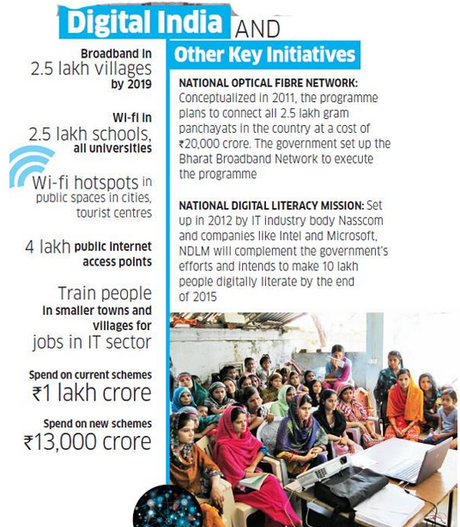Hey everyone!
As you all know that India has the second largest population next to China but in case of technology - India is always dominated. I still remember my grand-mother saying that watching television in her days was a dream, connecting to our by Best Offers"> by Best Offers"> by Best Offers">loved


A vision of #DigitalIndia
#DigitalIndia is an initiative of Government of India to deepen the connection between government departments and people of India.It’s two main aims are
- To connect rural areas with high-speed internet networks.
- To ensure that government services are available to the citizens of India electronically.
Three core components of Digital India are
- Digital Infrastructure
- Digital Literacy
- Delivering services digitally
Key Mantra is IT (India Today) + IT (Information Technology) = IT (India Tomorrow)
The major challenges
- Mandatory e-governance services in India reaching out to every part of the country.
- Poor regulations in fields of data privacy and cyber laws
E-Governance through technology
Technology has revolutionized the way information can be send to and received from any part of the world. Today we can connect with any person sitting in any part of the world within few seconds.The same can be used by the Indian government for better governance known as e-governance.
There are 4 models in e-governance.
- Government to citizens
- Government to business
- Government to government
- Government to employees
Today, India is moving towards a great vision: where a farmer in a village can get the information about the right pesticide right there in his mobile inbox; where a school won’t be the only destination for education but e-Education would facilitate 24×7 learning space; where a patient in a core village can get the information about the medicine in his/her mobile if the doctor is not available nearby; and where a person at any corner of India can log on a complain in a centralized portal and get back his/her right.
This is what e-Governance is and all these can be possible with the application of Information and Communication Technology (ICT). The technical knowledge needed to provide e-Governance has been already achieved. But the main challenges are to set a proper plan and the need of man power and infrastructure to execute the plan. Spreading awareness among the village people and to make them technology friendly are other big challenges. The main aim of Digital India is to make government services available to every citizen of India electronically.To achieve this motto, the first step is to make the people especially those living in the rural areas, tech literate.To achieve this Indian government has joined hands with one of the biggie of the technology world, Intel.Our democracy must be reformed into a participatory democracy- one where citizens are constantly connected to decision making and policy making bodies. Citizens should be involved in the policy formulation and various other tasks of the Government. Involving citizens not only make sure that citizens feel being part of the process, but it also ensures that the process immensely benefits from the collaboration of thousands of intelligent minds! Here are a few specific suggestions in this regard -- Whenever new policy or law are being formulated, it should be put up in public, on a website, for taking suggestions of citizens. The suggestions could be further voted upon by other fellow citizens. The most voted suggestions should be discussed by law makers. If they are feasible, they should be included in the policy being formulated.
- If a large section of citizens are opposed to a law being brought up, their concerns must be looked into. Depending upon suggestions and criticism of people on the online platform, corrective measures should be taken.
- Whenever a new development project is being undertaken, suggestions should be sought from public, on how best to carry on the project. The best ideas could be given some incentives too.
- In this direction (of involving citizens), the government of India has already taken a nice initiative in form of the website mygov.in. Ideas are being asked there, and best ones are awarded too. The same model of collaboration needs to be expanded to other areas too.

